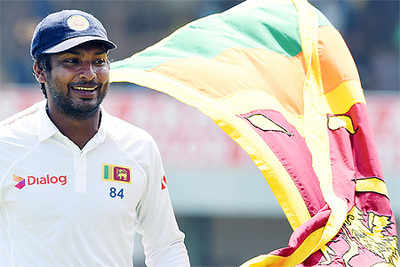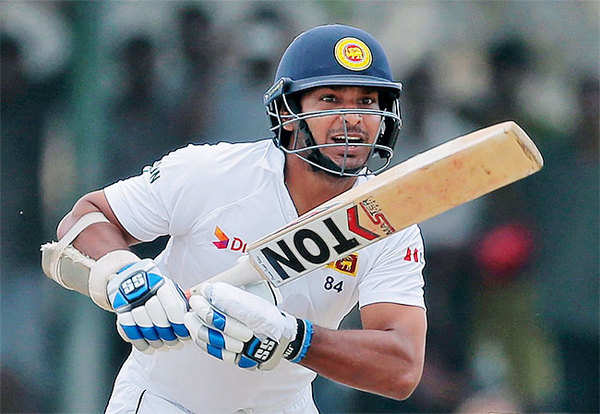- News
- Sports News
- Kumar Sangakkara - A multi-faceted batting legend
Trending
This story is from August 20, 2015
Kumar Sangakkara - A multi-faceted batting legend
One of the most exquisitely engineered batting machines of his age, Sangakkara's charismatic, erudite presence exuded a statesman-like quality.

One of the most exquisitely engineered batting machines of his age, Sangakkara's charismatic, erudite presence exuded a statesman-like quality.
One of the most exquisitely engineered batting machines of his age, Kumar Sangakkara's charismatic, erudite presence also exuded a statesman-like quality in short supply among his contemporaries.
Bid adieu to Kumar Sangakkara
These days, cricketers, especially the most competitive of them, often come across as a boorish, testy lot thriving in the socially-isolated bubble created by team managements and coaches.A recent India captain, at one stage, proudly proclaimed that he did not read newspapers or watch TV, presumably to avoid heartache if he stumbled into cricketing discussions.
The Australians, who are expected to flaunt a workmanlike manner, can be downright crass and loutish when it comes to the crunch on the field. Like politicians who think only of the next election, modern cricketers are taught to focus only on the next game, the next win. Witness Bangladesh's recent resurgence, which has also unleashed a distinctly edgy, vocally combative, often abusive aspect to the team.
Above all, perspicacity enabled him to become an admired Sri Lankan social unifier, a national icon who didn't shy away from addressing the difficult, relevant issue of ethnic strife. Sangakkara is, then, the ideal ambassador we want all legendary cricketers to be, and there can be no doubting his 'legend' status or wondrous batting abilities -there will be reams written about his exact place in the hall of fame as he plays his last Test.

Sangakkara was adroit at maintaining his perspective in the high-pressure cauldron of international cricket. (AFP Photo)
While not as sublime as Mahela Jayawardene or as fluid as Aravinda, the left-hander was in many ways a late bloomer, an exacting taskmaster when it came to his own batting -who chiselled away at the imperfections until he could achieve an acceptable level , of consistency . At an age when batsmen usually cut down on their strokes, he was adding innovative stuff like the ramp shot, complementing the famous bent-knee cover drive with slog sweeps, pulls and scoops.
He was also a marvellous advert for batsmen-wicketkeepers to cut down on their 'keeping -averaging 67.39 in 85 games after giving up the gloves in Tests. He has the highest home average of 61.08 among batsmen with at least 6,000 Test runs, but was no weakling away -in Australia he averaged 60.33 (who can forget the 192 in Hobart), 61 in New Zealand (80.5 when not 'keeping), 48.5 in India as a captain and non-wicketkeeper. He has the highest batting average ever at No. 3 for those with a minimum of 8,000 runs -61.20 to Ponting's 56.27.
He has the third-highest batting average of all time among captains who led in at least 15 Tests. He has one less double century than the maximum ever: Bradman's 12. The awe-inspiring numbers could fill a whole book. "Most of the things I do don't seem elegant, but I'm glad I made up with the amount of runs I've scored and how effective I've been," Sanga said recently, summing it up better than anyone can.
But that's in the past. As Sanga looks beyond life with bat in hand, it is also time to recognize his impact off the field as a leading cricketer. Remember, it was only Sanga among cricketers who spoke out against the ban on Lankan players in Chennai, saying, "Politics will never curtail the spirit of the game."
During the Suraj Randiv no-ball incident which threatened to disrupt player relations between India and Lanka on the 2010 tour, Sangakkara said, "We have regretted it (the incident). We are trying to do the right thing. (But) we can't expect one side to keep holding out the hand while it has been sensationalized by other players."
In the now-famous Cowdrey Lecture in 2011, it was Sanga who talked about his family sheltering Tamils during the race riots of '83, adding, "I am Tamil, Sinhalese, Muslim and Burgher. I am a Buddhist, a Hindu, a follower of Islam and Christianity ."
It is Sanga, along with Muralitharan, who has adopted Mankulam, one of the flashpoints of Lanka's war.
It was also, in the same lecture, that Sanga dwelt on cricket's current existential crisis, saying, "We have reached a critical juncture in the game's history... unless we better sustain Test cricket, embrace technology enthusiastically , protect the game's global governance from narrow self-interest, and more aggressively root out corruption, then cricket will face an uncertain future."
The International Cricket Council (ICC) is caught at a crossroads when it comes to juggling scheduling issues, addressing shortening attention spans and managing business interests and multiple formats. As it charts the game's future, the ICC could do well to mine Sanga's immense nous when it comes to standing up for cricket's spirit and sanctity in changing times. He is already among the players' representatives in the ICC cricket committee, but it may be time for a bigger role.
The Lankan hero has said he will not immediately embrace politics. It is time for cricket's administration, then, to embrace Sanga's vision anew by giving him a new role.
Follow TOI Sports on Twitter >>> @TOISportsNews
Bid adieu to Kumar Sangakkara
These days, cricketers, especially the most competitive of them, often come across as a boorish, testy lot thriving in the socially-isolated bubble created by team managements and coaches.A recent India captain, at one stage, proudly proclaimed that he did not read newspapers or watch TV, presumably to avoid heartache if he stumbled into cricketing discussions.
The Australians, who are expected to flaunt a workmanlike manner, can be downright crass and loutish when it comes to the crunch on the field. Like politicians who think only of the next election, modern cricketers are taught to focus only on the next game, the next win. Witness Bangladesh's recent resurgence, which has also unleashed a distinctly edgy, vocally combative, often abusive aspect to the team.
It is here that Sangakkara was different. He was adroit at maintaining his perspective in the high-pressure cauldron of international cricket. The qualities which made him an ever-improving, ever-evolving batting artisan who compiled runs and milestones at an exponential rate, also contributed to making him many other things -as astute sledger who never resorted to invectives, a clever leader who knew how to maximize team input, a batsman supremely skilled at adapting to changing times and conditions.
Above all, perspicacity enabled him to become an admired Sri Lankan social unifier, a national icon who didn't shy away from addressing the difficult, relevant issue of ethnic strife. Sangakkara is, then, the ideal ambassador we want all legendary cricketers to be, and there can be no doubting his 'legend' status or wondrous batting abilities -there will be reams written about his exact place in the hall of fame as he plays his last Test.

Sangakkara was adroit at maintaining his perspective in the high-pressure cauldron of international cricket. (AFP Photo)
While not as sublime as Mahela Jayawardene or as fluid as Aravinda, the left-hander was in many ways a late bloomer, an exacting taskmaster when it came to his own batting -who chiselled away at the imperfections until he could achieve an acceptable level , of consistency . At an age when batsmen usually cut down on their strokes, he was adding innovative stuff like the ramp shot, complementing the famous bent-knee cover drive with slog sweeps, pulls and scoops.
He was also a marvellous advert for batsmen-wicketkeepers to cut down on their 'keeping -averaging 67.39 in 85 games after giving up the gloves in Tests. He has the highest home average of 61.08 among batsmen with at least 6,000 Test runs, but was no weakling away -in Australia he averaged 60.33 (who can forget the 192 in Hobart), 61 in New Zealand (80.5 when not 'keeping), 48.5 in India as a captain and non-wicketkeeper. He has the highest batting average ever at No. 3 for those with a minimum of 8,000 runs -61.20 to Ponting's 56.27.
He has the third-highest batting average of all time among captains who led in at least 15 Tests. He has one less double century than the maximum ever: Bradman's 12. The awe-inspiring numbers could fill a whole book. "Most of the things I do don't seem elegant, but I'm glad I made up with the amount of runs I've scored and how effective I've been," Sanga said recently, summing it up better than anyone can.
But that's in the past. As Sanga looks beyond life with bat in hand, it is also time to recognize his impact off the field as a leading cricketer. Remember, it was only Sanga among cricketers who spoke out against the ban on Lankan players in Chennai, saying, "Politics will never curtail the spirit of the game."
During the Suraj Randiv no-ball incident which threatened to disrupt player relations between India and Lanka on the 2010 tour, Sangakkara said, "We have regretted it (the incident). We are trying to do the right thing. (But) we can't expect one side to keep holding out the hand while it has been sensationalized by other players."
In the now-famous Cowdrey Lecture in 2011, it was Sanga who talked about his family sheltering Tamils during the race riots of '83, adding, "I am Tamil, Sinhalese, Muslim and Burgher. I am a Buddhist, a Hindu, a follower of Islam and Christianity ."
It is Sanga, along with Muralitharan, who has adopted Mankulam, one of the flashpoints of Lanka's war.
It was also, in the same lecture, that Sanga dwelt on cricket's current existential crisis, saying, "We have reached a critical juncture in the game's history... unless we better sustain Test cricket, embrace technology enthusiastically , protect the game's global governance from narrow self-interest, and more aggressively root out corruption, then cricket will face an uncertain future."
The International Cricket Council (ICC) is caught at a crossroads when it comes to juggling scheduling issues, addressing shortening attention spans and managing business interests and multiple formats. As it charts the game's future, the ICC could do well to mine Sanga's immense nous when it comes to standing up for cricket's spirit and sanctity in changing times. He is already among the players' representatives in the ICC cricket committee, but it may be time for a bigger role.
The Lankan hero has said he will not immediately embrace politics. It is time for cricket's administration, then, to embrace Sanga's vision anew by giving him a new role.
Follow TOI Sports on Twitter >>> @TOISportsNews
End of Article
FOLLOW US ON SOCIAL MEDIA










